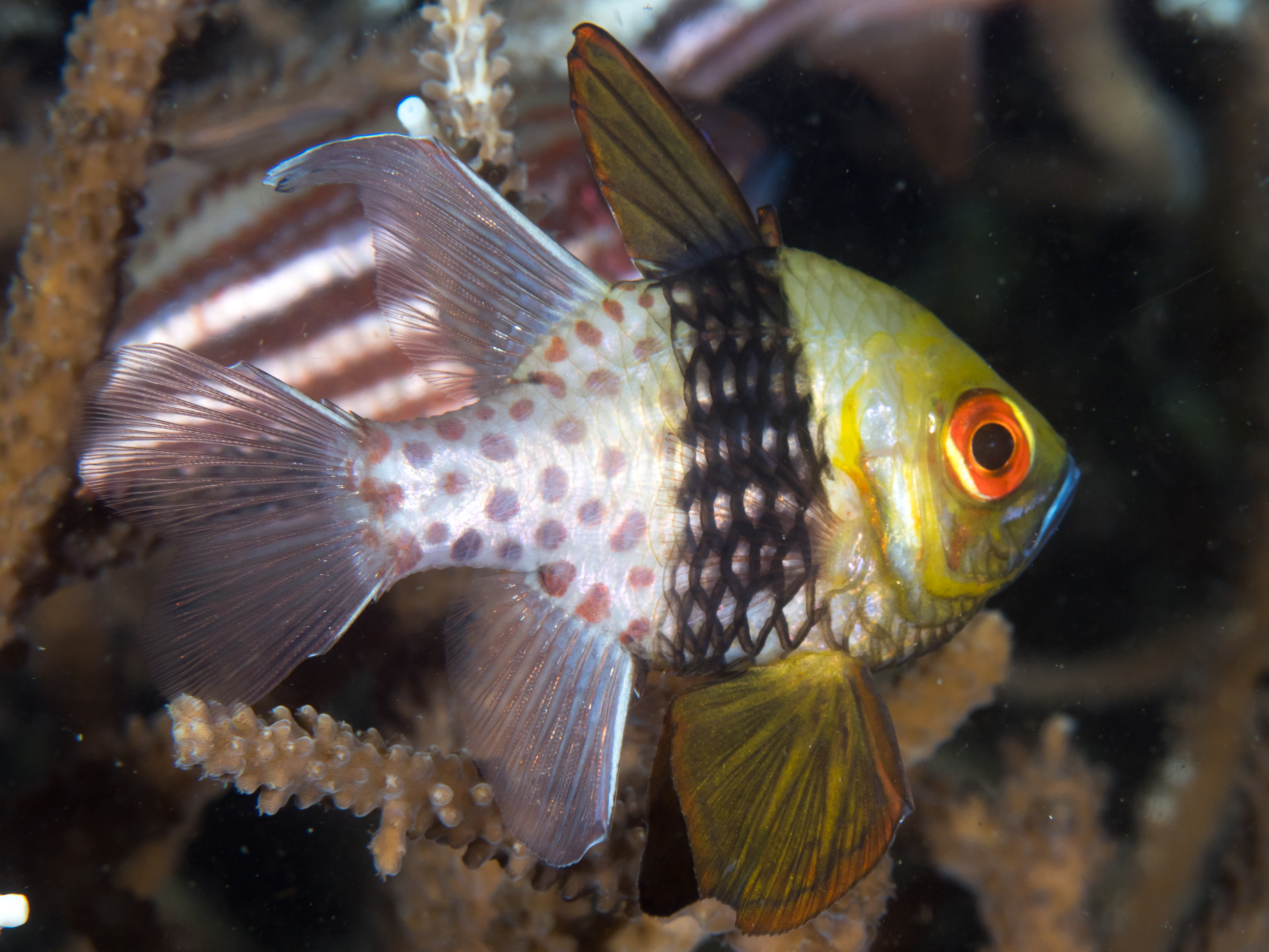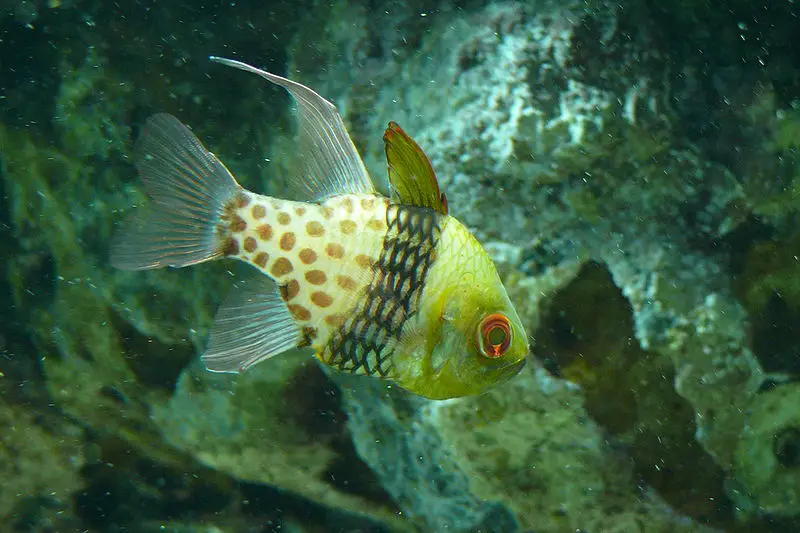The pajama cardinalfish is a really striking looking swimmer which offers all kinds of patterns and markings and is perhaps best known for its stunning eyes! This is a common little critter that hails from Indonesia and is likely to be a great addition to any saltwater tank.

Keep reading, and we will fill you in on everything you need to know about the pajama cardinalfish.
- Fish Lifespan: Up to 5 Years
- Tank Size: At Least 20 Gallons
- Water Temperature: Between 72F and 78F
- pH: Between 8.1 and 8.4
- Hardness: Between 8 and 12 dKH
- Compatibility: Compatible with Basslets and Some Angelfish
- Fish Size: Up to 4 Inches
How do you take care of pajama cardinalfish?
The pajama cardinalfish is easily one of the most bizarre-looking creatures you’ll probably host in your saltwater tank, and we mean that it the best way possible. This big-eyed beast is very peaceful and is often seen as one of the easiest critters to start looking after as part of your own saltwater tank. Therefore, if you have a sizeable tank and are looking to start up a friendly community, these cardinals are probably a good place to start.
In fact, the pajama cardinalfish is a bit of an oddity to its species. It actually won’t antagonise or be aggressive towards others of its species when it wants to be dominant. Yes, there is a school hierarchy with pajama cardinals, but there’s no muscling for position.
Pajama cardinals need quite a few places to hide and camouflage, as they don’t always enjoy being out in the open. Therefore, you should invest in a larger tank with lots of rocks and plants that they can flit and flutter between. They tend to swim slower than many other fish you’ll host in a saltwater tank, so make sure to give them plenty of breathing space. They might not do well with other fish that are slightly aggressive, or those which dart about a lot.
However, there may be occasions where they get on well with angelfish, who are known to have something of a reputation. That said, regardless of who you bring into the same tank, always make sure it is big enough for all your critters to comfortably reside in their own spaces and corners of the tank.
The pajama cardinalfish is a carnivore and is easy to feed. As it doesn’t have many specific water needs beyond the average water temperatures and pH levels you’d expect for a saltwater fish, it’s unlikely looking after them will pose problems for you.
How many pajama cardinals should I get?
Pajama cardinals tend to do well in smaller schools. They get on well with each other and won’t fight, which means you won’t have to look after just one or two in their own tank elsewhere.

That said, the number of pajama cardinals you should get for your tank will, of course, depend on the size of your aquarium! The size of your tank, as the maths state, should be around two gallons of area per one inch of fish. Take into account that the pajama cardinal can grow to be 4 inches long at maximum, and you’ll probably need 20 gallons to comfortably house two.
However, there are some cardinals which only ever grow to be tiny. They could be as small as ¾ of an inch! However, in our collective opinion, it is always a good idea to account for the max size of your fish, rather than to just assume they are going to be tiny. That’s probably not a good measure moving forwards!
Are pajama cardinals aggressive?
Not at all. In fact, pajama cardinals are some of the least aggressive fish you will ever host in a saltwater tank.
Like other cardinalfish, the pajama species has a pecking order and will therefore have some fish who receive favour over others. However, as mentioned, the pajama variety will very rarely kick up a fuss. They seem to co-exist pretty peacefully. However, these fish can get stressed out much like any other, and if you were a fish of this size – it’s likely you’d be feeling a bit under pressure from bigger creatures, too.
Therefore – try and house them together in their own tank, alongside other fish who are peaceful by nature. This way, you can be sure that your fish aren’t going to come to any harm. Just because pajama cardinals aren’t going to kick off any fights, doesn’t mean there aren’t going to be bigger brutes who really want to try it on with them.
Generally, pajama cardinals will go and hide somewhere if they feel under threat or stressed out. Therefore, always make sure to set up your tank with lots of hiding places for them to scurry into. These fish are also masters of disguise, as they love to camouflage themselves against certain plants and shrubbery in the water.
How long do pajama cardinal fish live?
Pajama cardinalfish tend to live decent lives, normally to around 5 years of age, though they are known to live for longer, too.

The longevity of your pajama cardinal will depend entirely on its environment, its diet, and how much attention you give it. While they are pretty easy to care for if you are just starting out, it is safe to assume that if you give them as much attention as possible, they are going to go on and thrive. Therefore, it may be best to start looking after these fish within a few years of you starting out, especially if you want them to live for a long time.
Looking after pajama cardinals isn’t hard. However, it can be hard to make sure they live to their full potential. This means keeping a special eye on their tank mates as well as their tank conditions. If you get a pajama cardinal that lives longer than 5 years, then you will know you have done a fantastic job!
What do pajama cardinal fish eat?
Pajama cardinal fish are carnivorous. This means that you won’t be able to feed them herbivore food or expect them to hoover up the algae in your tank any time soon.
Instead, you should be ready to feed them a good balance of meat. For carnivorous fish of this size, this means you should ideally offer them a variety of meaty shrimp. Feeder shrimp are a good start, but you may also want to consider feeding them bloodworms.
You can also help to boost a pajama cardinal’s diet with fish pellets and flakes, as these will be developed to appeal to a meat eater’s diet. There is also the fact that you should be able to offer these fish live food when they grow big enough. This might not always be possible depending on the specific case, so make sure to keep an open mind.
All in all, it should be easy for you to feed this type of fish. As they can be so tiny, it’s unlikely they will have much to prey on in your tank and risk upsetting the ecosystem balance. However, try and keep these fish around the same size as everything else in your tank, and you won’t have to worry about anyone ending up as fish food inadvertently.
How many fish can be in a cardinal tank?
Again, that all depends on how large your tank is. The pajama cardinalfish mixes well with others, meaning there shouldn’t be that much of a problem you introducing alternative schools of fish along the way.

If you invest in a 50 gallon tank then technically you will be able to host five or six cardinals comfortably in the same aquarium. You must make sure that you account for other plants, smaller creatures and anything else that’s likely to need room and space. Otherwise, you could end up making things pretty stressful for a whole host of fish.
Ultimately, different tank sizes will vary depending on the species of fish you want to keep. There are even cardinals out there who are going to be markedly different from most, so make sure to consult your local aquarium or pet store expert for full advice on this.
Should I adopt a pajama cardinalfish?
Absolutely! The pajama cardinal is very mellow and is likely to be extremely chilled out. They work well with each other and providing you house them with other fish of the same size and temperament, you’ll be able to use them to add a bit of charm and character to almost any tank.
The pajama cardinal is a very easy pet to look after, meaning they are superb choices for beginners. Of course, if you already have a tank set up and are simply looking to add a bit of variety, then you should also go right ahead and consider these cardinals! These are beautiful fish which really do make for the best talking points, so make a point of introducing them slowly into your own tanks.



